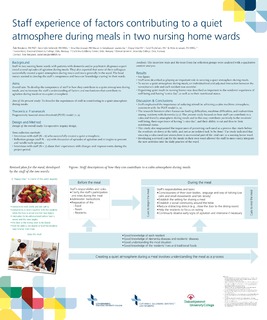| dc.description.abstract | Background: Staff in two nursing home wards with patients with dementia and/or psychiatric diagnoses experienced several episodes of agitation during meals. They also reported that some of their colleagues successfully created a quiet atmosphere during meals and more generally in the ward. The head nurses wanted to develop the staff’s competence and focus on ‘knowledge sharing’ in their wards. Aims Overall aim: To develop the competence of staff in how they contribute to a quiet atmosphere during meals, and to increase the staff’s understanding of factors and mechanisms that contribute to agitation during meals or to a quiet atmosphere.
Aim of the present study: To describe the experiences of staff in contributing to a quiet atmosphere during meals.
Theoretical Framework Progressively lowered stress threshold (PLST) model (1, 2).
Design and Method Design of the overall study: Co-operative inquiry design.
Data collection methods: • Interviews with staff (N = 6) who successfully created a quiet atmosphere. • Refl ection groups (staff N = 20) with discussion of episodes of agitation and strategies to prevent and handle such episodes. • Interviews with staff (N = 7) about their experiences with changes and improvements during the project period. Analysis: The interview texts and the texts from the refl ection groups were analysed with a qualitative content analysis.
Results • See fi gure. • Staff were described as playing an important role in securing a quiet atmosphere during meals. • To secure a quiet atmosphere during meals, an individualized and adjusted interaction between the nurse/nurse’s aide and each resident was essential. • Organizing quiet meals in nursing homes was described as important to the residents’ experience of well-being and having “a nice day”, as well as to their nutritional status.
Discussion & Conclusions • Staff emphasized the importance of reducing stimuli in achieving a calm mealtime atmosphere, consistent with the PLST model (1, 2). • The research literature often focuses on feeding diffi culties, mealtime diffi culties, and malnutrition among residents with dementia (3-7). The present study focused on how staff can contribute to a calm and friendly atmosphere during meals and in this way contribute positively to the residents’ well-being, their experience of having “a nice day”, and their ability to eat and thus to their nutritional status. • This study also emphasized the importance of perceiving each meal as a process that starts before the residents sit down at the table, and not as an isolated task ‘to be done’. The study indicated that ensuring a calm mealtime atmosphere is an essential part of the total care in a nursing home ward. • Developing a revised plan for the meals in their own ward allowed the staff to more easily integrate the new activities into the daily practice of the ward. | no_NO |
